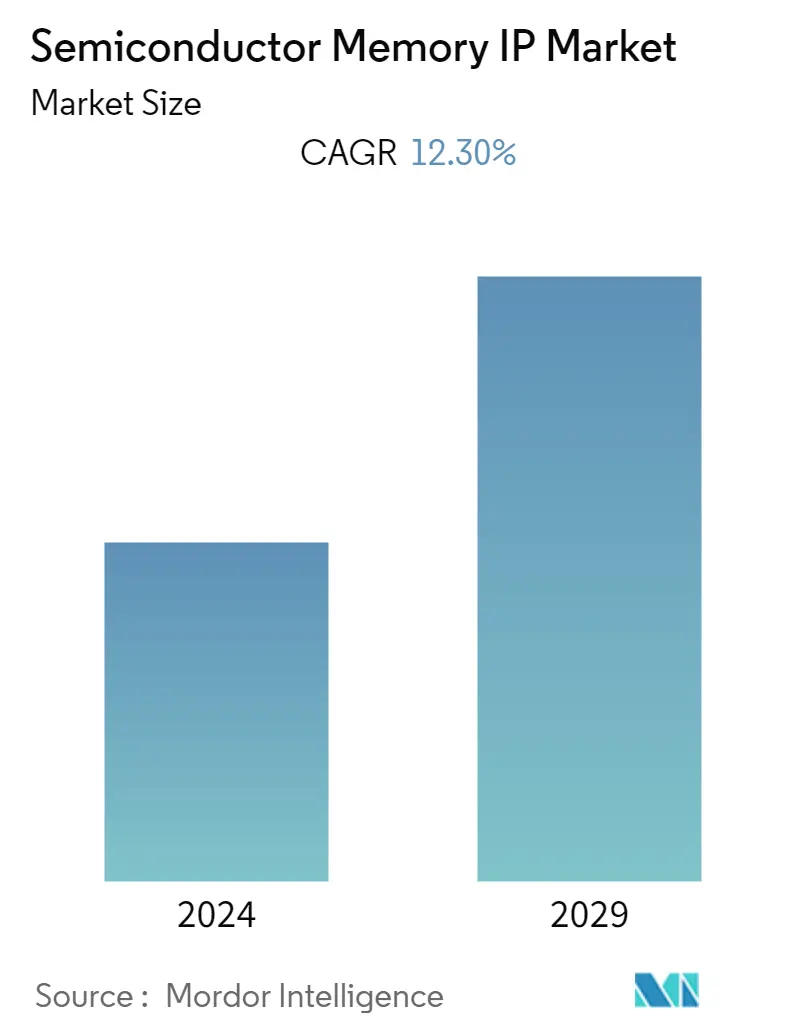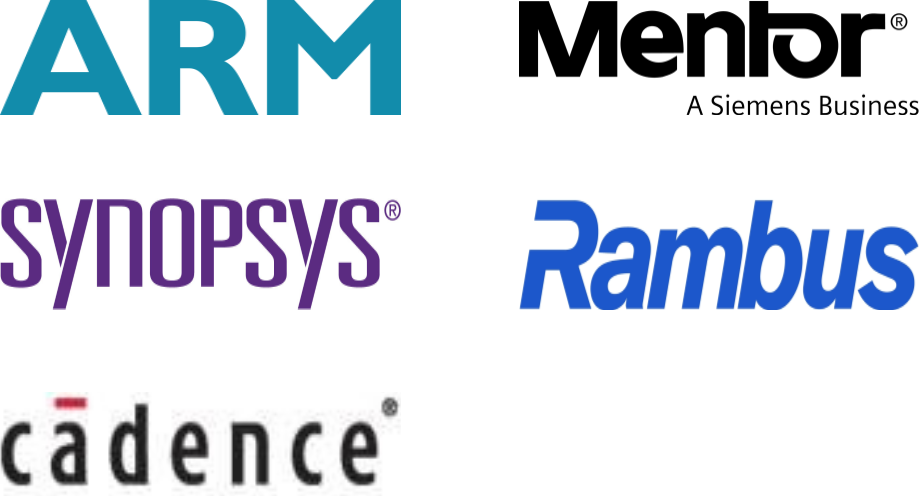Market Size of Semiconductor Memory IP Industry

| Study Period | 2019 - 2029 |
| Base Year For Estimation | 2023 |
| CAGR | 12.30 % |
| Fastest Growing Market | Asia Pacific |
| Largest Market | Asia Pacific |
| Market Concentration | Low |
Major Players*Disclaimer: Major Players sorted in no particular order |
Semiconductor Memory IP Market Analysis
The Semiconductor Memory IP Market was valued at USD 5.92 billion in 2020 and expected to reach USD 11.90 billion by 2026 and grow at a CAGR of 12.3% over the forecast period (2021-2026). In electronic design, a semiconductor intellectual property core, IP core, or IP block is a reusable unit of logic, cell, or integrated circuit (commonly called a "chip") layout design that is the intellectual property of one party. IP cores may be licensed to another party or can be owned and used by a single party alone. The term is derived from the licensing of the patent and/or source code copyright that exists in the design.
- Semiconductor memory IP is witnessing direct impact of the growing demand for high-performance memory systems across all the end-user verticals. Increasing complexity of the semiconductors and growing demand for intense memory operations are resulting in a demand for faster and efficient memory solutions in the market.
- Companies are investing in developing efficient memory solutions. IoT, automation, and autonomous vehicle technologies due to which expansion is happening at a rapid pace. There has been driving demand for new types of semiconductor infrastructure which will support the growth of this market.
- There are high costs associated with the technology. The cost of its adoption is high due to which it has hampered the growth of this market.
Semiconductor Memory IP Industry Segmentation
| By Product | |
| Volatile Memory | |
| Non - Volatile Memory | |
| Other Products |
| By End -user Industry | |
| Consumer Electronics | |
| Industrial | |
| Automotive | |
| Networking | |
| Other End-user Industries |
| Geography | |||||||
| |||||||
| |||||||
| |||||||
|
Semiconductor Memory IP Market Size Summary
The Semiconductor Memory IP market is experiencing significant growth driven by the increasing demand for high-performance memory systems across various end-user sectors. This demand is fueled by the rising complexity of semiconductors and the need for faster, more efficient memory solutions, particularly in industries such as IoT, automation, and autonomous vehicles. Companies are heavily investing in the development of advanced memory technologies to keep pace with these trends. However, the high costs associated with adopting these technologies pose a challenge to market expansion. The market is also witnessing a surge in demand for DRAM, which is widely used in devices like laptops, computers, and video game consoles, further propelling the market's growth.
The smartphone industry plays a crucial role in the semiconductor memory market, with the increasing sales of smartphones presenting substantial opportunities for manufacturers. Flash memory, a prevalent technology in smartphones, significantly impacts the market's dynamics in consumer electronics. The growing popularity of AI-enabled applications is driving the need for faster processors and larger, more affordable storage solutions. This trend is evident in the advancements showcased by major memory and storage companies at events like CES. In North America, the demand for intelligent command and control systems is creating important market opportunities, prompting companies like Hitachi to consolidate resources and focus on semiconductor system solutions. Despite some fluctuations in market growth, the demand for DRAM remains strong, particularly with the rise of data centers, highlighting the importance of a robust memory and storage hierarchy in modern IT infrastructure. The market is highly competitive, with major players dominating and ongoing investments in research and development to reduce manufacturing costs and enhance product offerings.
Semiconductor Memory IP Market Size - Table of Contents
-
1. MARKET DYNAMICS
-
1.1 Market Overview
-
1.2 Industry Attractiveness - Porter's Five Force Analysis
-
1.2.1 Threat of New Entrants
-
1.2.2 Bargaining Power of Buyers/Consumers
-
1.2.3 Bargaining Power of Suppliers
-
1.2.4 Threat of Substitute Products
-
1.2.5 Intensity of Competitive Rivalry
-
-
1.3 Industry Value Chain Analysis
-
1.4 Market Drivers
-
1.4.1 Complex Chip Design and Multi core Technologies
-
1.4.2 Increasing Investments in the Semiconductor Industry
-
-
1.5 Market Restraints
-
1.5.1 High Cost of Systems
-
-
-
2. MARKET SEGMENTATION
-
2.1 By Product
-
2.1.1 Volatile Memory
-
2.1.2 Non - Volatile Memory
-
2.1.3 Other Products
-
-
2.2 By End -user Industry
-
2.2.1 Consumer Electronics
-
2.2.2 Industrial
-
2.2.3 Automotive
-
2.2.4 Networking
-
2.2.5 Other End-user Industries
-
-
2.3 Geography
-
2.3.1 North America
-
2.3.1.1 United States
-
2.3.1.2 Canada
-
-
2.3.2 Europe
-
2.3.2.1 United Kingdom
-
2.3.2.2 Germany
-
2.3.2.3 France
-
2.3.2.4 Rest of Europe
-
-
2.3.3 Asia Pacific
-
2.3.3.1 China
-
2.3.3.2 Japan
-
2.3.3.3 South Korea
-
2.3.3.4 Taiwan
-
2.3.3.5 Rest of Asia-Pacific
-
-
2.3.4 Rest of the World
-
2.3.4.1 Latin America
-
2.3.4.2 Middle-East & Africa
-
-
-
Semiconductor Memory IP Market Size FAQs
What is the current Semiconductor Memory IP Market size?
The Semiconductor Memory IP Market is projected to register a CAGR of 12.30% during the forecast period (2024-2029)
Who are the key players in Semiconductor Memory IP Market?
ARM Limited, Rambus Inc, Cadence Design Systems, Inc., Synopsys, Inc. and Mentor Graphics Corporation are the major companies operating in the Semiconductor Memory IP Market.


